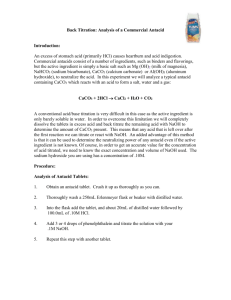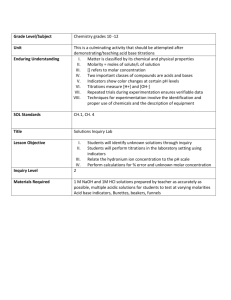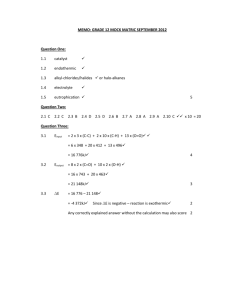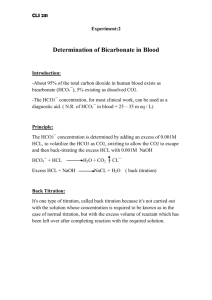CHEM 2124
advertisement
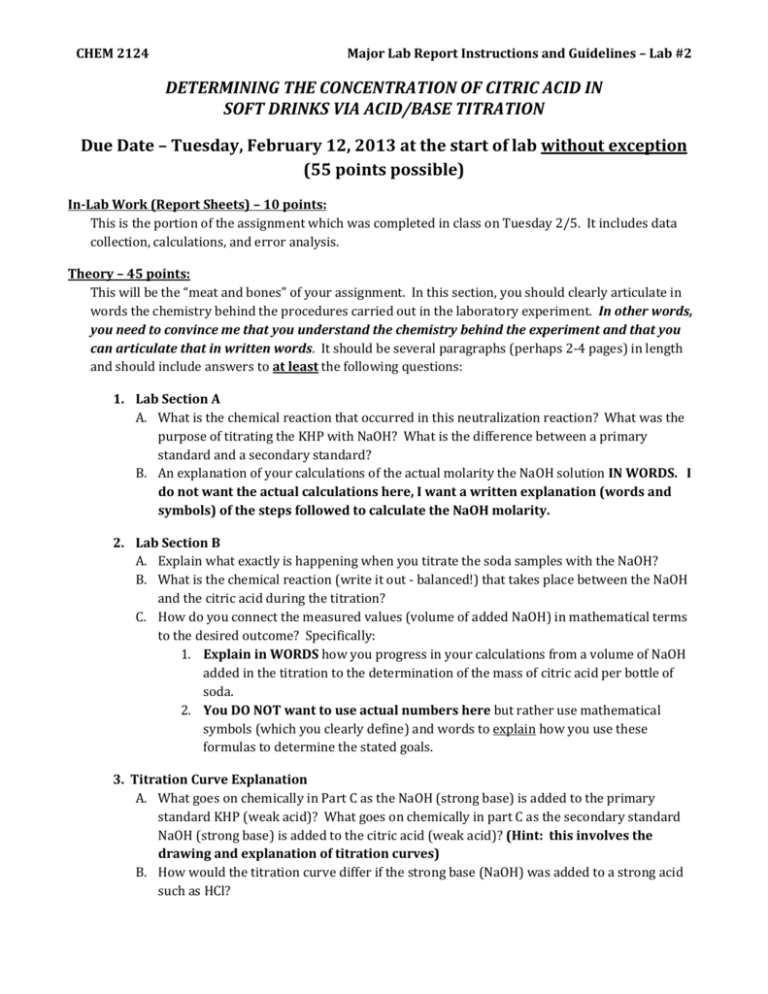
CHEM 2124 Major Lab Report Instructions and Guidelines – Lab #2 DETERMINING THE CONCENTRATION OF CITRIC ACID IN SOFT DRINKS VIA ACID/BASE TITRATION Due Date – Tuesday, February 12, 2013 at the start of lab without exception (55 points possible) In-Lab Work (Report Sheets) – 10 points: This is the portion of the assignment which was completed in class on Tuesday 2/5. It includes data collection, calculations, and error analysis. Theory – 45 points: This will be the “meat and bones” of your assignment. In this section, you should clearly articulate in words the chemistry behind the procedures carried out in the laboratory experiment. In other words, you need to convince me that you understand the chemistry behind the experiment and that you can articulate that in written words. It should be several paragraphs (perhaps 2-4 pages) in length and should include answers to at least the following questions: 1. Lab Section A A. What is the chemical reaction that occurred in this neutralization reaction? What was the purpose of titrating the KHP with NaOH? What is the difference between a primary standard and a secondary standard? B. An explanation of your calculations of the actual molarity the NaOH solution IN WORDS. I do not want the actual calculations here, I want a written explanation (words and symbols) of the steps followed to calculate the NaOH molarity. 2. Lab Section B A. Explain what exactly is happening when you titrate the soda samples with the NaOH? B. What is the chemical reaction (write it out - balanced!) that takes place between the NaOH and the citric acid during the titration? C. How do you connect the measured values (volume of added NaOH) in mathematical terms to the desired outcome? Specifically: 1. Explain in WORDS how you progress in your calculations from a volume of NaOH added in the titration to the determination of the mass of citric acid per bottle of soda. 2. You DO NOT want to use actual numbers here but rather use mathematical symbols (which you clearly define) and words to explain how you use these formulas to determine the stated goals. 3. Titration Curve Explanation A. What goes on chemically in Part C as the NaOH (strong base) is added to the primary standard KHP (weak acid)? What goes on chemically in part C as the secondary standard NaOH (strong base) is added to the citric acid (weak acid)? (Hint: this involves the drawing and explanation of titration curves) B. How would the titration curve differ if the strong base (NaOH) was added to a strong acid such as HCl? A couple of warnings about the theory section: 1. DO NOT simply answer these questions in bullet or list form. You need to clearly articulate the thoughts you have to these questions in SENTENCE and PARAGRAPH form. You are writing a scientific paper here – not simply answering a list of questions. Any paper which simply lists answers will receive 0 points for the theory section. (see the attached example of a theory section) 2. Spend some time on this section. This is the section in which you explain and describe to me your knowledge of the chemistry in this lab. Anyone can follow directions and come up with number answers which can be plugged in to equations. A well-written report will do this and explain the chemistry involved. You WILL NOT be able to complete this assignment in 2 hours – trust me. You will be mad at both me and yourself if you wait until the last minute to start this assignment!!! Extra Credit Post-Lab Question – Answer along with your major lab write-up (+5 points possible – partial credit IS given but I can offer NO help!) In an early TV commercial for Rolaids antacid tablets, the manufacturer claimed that the tablet would neutralize 47 times its own weight of stomach acid. A tablet of Roalids weighs 1.400 g and contains 0.334 g of the active ingredient, NaAl(OH)2CO3. Assume that the active ingredient reacts with HCl according to the reaction: NaAl(OH)2CO3 + 4 HCl NaCl + AlCl3 + 3 H2O + CO2 a) How many moles of HCl would one Rolaids tablet neutralize? b) Stomach acid is about 0.155 M HCl and has about the same density as water. Did the Rolaids tablet neutralize 47 times its own weight of HCl solution? Prove your answer mathematically. Remember that this written report is due at the START of lab next Tuesday, February 12, 2013. NO late papers will be accepted and this lab counts for more than five times a normal lab grade!!!! Sample of Desirable text for portions of the Theory Section (Do not copy this on your submission – doing so shows me no effort or understanding on your part and is an example of plagiarism which will lead to an automatic grade of zero on this assignment!!!!) Determining the mass of CaCO3 from experiment – Note this is an example only – DO NOT write this exactly as written – You must explain the actual steps carried out in the laboratory exercise you completed. Antacid Active Ingredient (CaCO3 determination) The desired measure of antacid content in the sample antacid tablet is: 1) Wt % CaCO3 = 100 x grams CaCO3 Mass of used sample (grams) The reaction stoichiometry listed above implies that: 2) Moles CaCO3 = ½ moles HCl at equivalence As before, (see equation 3) we can determine the moles of HCl added using the equation: 3) CaVa = moles acid (HCl) Thus: 4) Moles CaCO3 = ½ CaVa Where Ca is the standard HCl concentration and Va is the volume of HCl added (in liters) at equivalence. Equation 8 is converted to grams by multiplying by the molecular mass of CaCO3 (100 g/mole): 5) Grams CaCO3 = 100 g/mole * (1/2 CaVa) Substitution of equation 5 into equation 1 connects the observables Va , Mass per tablet, and Ca to the desired measure of antacid content: 6) Wt % CaCO3 = grams CaCO3 Mass sample used (g) x 100 = (100 g/mole * ½ CaVa) x 100 Mass sample used (g) Finally, to calculate the mass of active ingredient (in mg) per tablet or antacid, the weight % of antacid is multiplied by the total mass (in grams) of the tablet analyzed as follows: 7) Mg of active ingredient per tablet = Wt % CaCO3 x total tablet mass (grams) x 1000 mg/gram Description of reaction behavior as titration proceeds For titration of citric acid, the initial pH is assumed to be low and near 0.5 * pKa of the acid H3A (where A = C6H5O6 3- ). As NaOH is added, the pH should rise intitailly but stabilize since the solution is now composed of the conjugate bases of citric acid, as well as untitrated H3C6H5O6. The pH prior to attainment of equivalence will be near the average of the pKa for the several ionized versions of citric acid. The several intermediate acid/conjugate base pairs that exist as titration occurs are listed below: a) OH- + H3A H2O + H2Ab) OH- + H2A- H2O + HA 2Insert sample titration curve 23c) OH + HA H2O + A sketch here These will, in principle, produce several minor waves in pH vs. mL acid added curve as sketched above. As equivalence is approached, however, solution pH will vary rapidly and upwards and when all the citric acid is consumed, pH will be ~ 7 + ½ pKa for the specific citric acid species, HA2-. Unlike the previous titration, pH of the initial solution of calcium carbonate will be high, reflecting the basic character of the solution. Addition of HCl will naturally lower the pH but the solution will form a buffer composed of HCO3- and CO32- initially, followed by the buffer H2CO3 and HCO3- as the HCl drives the intermediate reactions below: a) H+ + CO3 2- HCO3b) H+ + HCO3 - H2CO3 H2O + CO2 Insert sample titration curve sketch here A sketch of the expected pH variation for this pair of intermediates in solution above illustrates their effects. When the equivalence point of the CaCO3 is reached with HCl, the pH will change rapidly and downwards as the last reaction above is completed. The pH at this point will be ~ 7 + ½ pKa for the species, HCO3 -.

